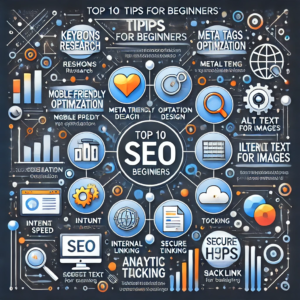Search Engine Optimization (SEO) is essential for improving website visibility and driving organic traffic. If you’re new to SEO, these beginner-friendly tips will help you build a strong foundation and boost your site’s rankings.

1. Conduct Keyword Research
Use tools like Google Keyword Planner, Ahrefs, or SEMrush to find relevant keywords. Focus on:
- Long-tail keywords (e.g., “best email marketing tool for small businesses”)
- Search intent (informational, transactional, navigational)
📌 Pro Tip: Target keywords with high search volume and low competition for better ranking potential.
2. Optimize Title Tags and Meta Descriptions
Your title tag and meta description are the first things users see on search engines. Make them:
- Engaging and descriptive
- Keyword-rich but natural
- Within character limits (60 characters for titles, 150-160 for meta descriptions)
📌 Example:
Title: “Top 10 Email Marketing Tools for Small Businesses in 2024”
Meta Description: “Discover the best email marketing platforms, features, and pricing for small businesses in 2024. Compare tools and find the perfect fit.”
3. Use Header Tags (H1, H2, H3) Correctly
Organize content with headers to improve readability and SEO. Use H1 for your page title and H2/H3 for subheadings.
📌 Why It Matters: Proper headers help search engines understand your content’s structure and improve user experience.
4. Create Quality, Engaging Content
Content is king. Google prioritizes well-written, informative, and original content that matches search intent. Focus on:
- Solving users’ problems
- Writing in a conversational tone
- Using examples, images, and statistics
📌 Pro Tip: Use a content calendar to post regularly.
5. Optimize Images for SEO
Images enhance content but can slow down your site if not optimized. Do this by:
- Compressing images using tools like TinyPNG
- Using descriptive file names (e.g., “email-marketing-tool.png”)
- Adding alt text with relevant keywords
📌 Why It Matters: Alt text improves accessibility and helps images rank in Google Image Search.
6. Build Internal and External Links
Linking is essential for SEO:
- Internal Links: Connect pages within your website to help users navigate easily.
- External Links: Link to reputable sources to increase credibility.
📌 Pro Tip: Use keyword-rich anchor text but avoid over-optimization.
7. Improve Website Speed
Site speed is a crucial ranking factor. Ensure fast load times by:
- Using a content delivery network (CDN)
- Enabling browser caching
- Minimizing plugins and using lightweight themes
📌 Check Speed: Use Google PageSpeed Insights for performance reports.
8. Make Your Site Mobile-Friendly
Google uses mobile-first indexing, meaning it prioritizes mobile versions of websites when ranking them. Use responsive design and ensure that:
- Pages load quickly on mobile
- Content fits all screen sizes
- Navigation is intuitive
📌 Test It: Use Google’s Mobile-Friendly Test Tool.
9. Use Secure HTTPS
Switch to HTTPS for a secure browsing experience. An SSL certificate encrypts sensitive information, builds trust, and signals security to Google.
📌 Why It Matters: Google gives preference to HTTPS sites in its rankings.
10. Monitor and Improve with Analytics
Use tools like Google Analytics and Google Search Console to track:
- Traffic Sources (organic, direct, social)
- Keyword Rankings
- Bounce Rates and Session Duration
- Backlinks and Site Health
📌 Action Tip: Use this data to adjust your SEO strategy regularly.
Bonus Tip: Stay Updated on SEO Trends
Search Engine Optimization is constantly evolving. Follow trusted blogs like Moz, Search Engine Journal, and Neil Patel’s blog to stay ahead of updates and best practices.
By applying these top 10 SEO tips for beginners, you’ll be well on your way to improving your site’s visibility, driving organic traffic, and building long-term success online. Let me know if you’d like more advanced tips! 🚀



